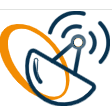
Radio Telescope
The Radio telescope application is used for radio telescope centers and observatories. It has been successfully deployed around the world for the last 5 years. The application note applies to the remote antenna of radio telescopes with a distance of above 1600 ft between the antenna and the control room. The system is comprised of indoor and outdoor units and is controlled by an HTML/WEB management system.
Why use RF over Fiber and not coax?
At radio telescope astronomy sites, the dish antenna is located at about 1600 ft. or more from the control building. This means that SMF fiber must be used between the two sites. Furthermore, using frequencies ranging from a few KHz to 18GHz does not allow using coaxial cables but rather optical fibers and RF over Fiber Technology.o electromagnetic interference (EMI), preserving phase information integrity for applications requiring precise direction finding.
Key characteristics
Generally, radio telescope observatories use RF over Fiber technologies to connect their huge dish antennas with the control room without using digital technologies. They prefer to use the entire bandwidth where noise figure and linearity are dominant factors.
An RF over Fiber (RFoF) link provides an electric-optic-electric signal converting solution. It is comprised of a Transmitter unit (Tx) that converts the analog RF input signal into an optically modulated signal and the receiver unit (Rx) that converts the optical signal back into an electrical RF signal. The optical modulation operates at optical wavelengths of 1310nm (for links below 10GHz) or 1550nm. Other wavelengths may be used in specific applications. The optical signal is transmitted from the Tx module to the Rx module over single-mode optical fiber(s) that aren’t part of the RFOptic solution (third-party product(s).
Main Applications
In most cases, frequencies from 0.1GHz to 18GHz or from 0.1GHz to 6GHz must be covered. In some cases, a mixture of the above frequencies is needed when there are a few antennas on the same site. RFOptic also provides other RF over Fiber solutions at different frequencies upon request. Our system for radio telescopes has been installed and is operational at various radio telescopes around the world, including at a state-sponsored Radio Astronomy Observatory dedicated to scientific research by operating a Very Long Baseline Interferometry Global Observing System (VGOS) radio telescope in Sweden, Germany, South Africa, and China.
A classical system structure is an outdoor enclosure close to the antenna with transmitters and remote management, and an indoor 1U removable enclosure with several receivers at the control side. This makes the radio telescope operate smoothly at the required bandwidth with excellent phase noise, phase linearity, and gain flatness.
System Configuration Example
RFOptic’s multilink RF over Fiber solution was customized to meet the specifications of one of the largest astronomical observatories. It comprises RFoF Transmit and RFoF Receive modules housed in outdoor and/or indoor enclosures. Each enclosure can house up to 4 RFoF Tx or Rx modules or more. The outdoor enclosure is populated with 2 Tx of 18GHz and 2Tx of 6GHz. The indoor rack mountable 1U removable chassis includes 2Rx of 18GHz and 2Rx 6GHz modules. An IFL module (interfacility link) is used for remote management when network connection near the antenna is not possible.
Deployment
The following paragraph describes a typical installation of RF over Fiber for a Radio Telescope.
Outdoor Units
- Install the outdoor unit using the 4 rack installation holes.
- Connect the ground cable to the ground screw.
- Remove the dust protective cap from the MPO fiber optic connector and connect it to the outdoor unit. Make sure that dust or debris didn’t penetrate the connector before connecting. It is important to keep the dust cap of the fiber-optic connector closed until connecting it. Dust particles can damage the polished glass surfaces of the fibers when connecting the connectors to each other.
- Connect the RF cables that have N-Type Male connectors to the outdoor unit according to the designed installation plan.
- Before connecting DC power to the outdoor unit, verify that the voltage is about 28 VDC at the outdoor connection end of the cable under the 3A load.
- Power off the DC power supply and connect the power cable to the POWER connector on the outdoor unit.
- Connect the data cable to the DATA connector on the outdoor unit. In a case of remote management, do not use the DATA connector.
Indoor Units
- Install the indoor unit on a table, a shelf, or inside a rack. When installed in a rack, bottom support is required.
- Connect the ground cable to the ground screw.
- Connect the fiber cable according to the specific instruction of the fiber optic cable supplier.
- Connect the RF cables, with SMA Male connector’s termination, to the indoor unit according to the designed installation plan.
- Verify that the connectors are fully closed and locked.
- Connect the data cable to the RJ-45 DATA connector on the back panel of the indoor unit.
- Connect the AC Power cord to the indoor unit.
Please note that installation is done by the customer using optical fibers with connectors.
RFOptic can provide the required cable(s) upon the customer’s request.
Monitoring & Control
RFOptic multilink products and subsystems may include a remote Management and Control (M&C) option. These products can be managed and controlled over the Internet Protocol (IP). This document describes the remote management and control capabilities and provides information necessary for the deployment of such products… The M&C supports HTML (AKA Web Server), REST, and SNMP V2c protocols.
In general, RFOptic products encompass RF Over Fiber (RFoF) wideband multilink, ODL test equipment, and custom subsystems. In reference to the above, it is worthwhile to consider the components of these RFoF products as modules or terminals, which can be either Rx or Tx, and subsystems such as an ODL. The M&C interface treats each of these components independently. For each component, the M&C displays all the associated statuses and control capabilities particular to that component under all the above interface protocols.
Conclusion
RF over Fiber is an excellent solution for remote antennas in radio telescope observatories since the solution requires wide bandwidth, good noise figure, and good gain flatness, together with the remote management and monitoring system. The above application of RFOptic is the proven solution that can be provided within a short time upon request.
Contact Us








